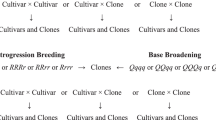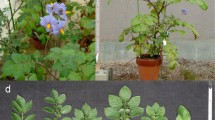Summary
Phureja-haploid Tuberosum hybrids, which produce 2n gametes in addition to n gametes, were used to obtain diploid progenies in 2x – 2x matings, and tetraploid progeny in 4x − 2x matings. Seven of these diploid clones were intermated in a modified diallel design, and also crossed to seven cultivars, to obtain 21, 16-clone diploid; and 49 (35, 2x X 4x and 14, 4x X 2x) 24-clone tetraploid families, respectively. These progenies were included together with the 14 parental clones, in a tuber yield trial conducted in two locations in Wisconsin. Heterotic responses were striking in 4x X 2x progenies. Three of these entries had mean yields of 5.0, 5.0 and 5.2 lbs/hill, for 24 unselected clones, thus outyielding not only the mid-parent but also the best tetraploid cultivars in the experiment, which are highly selected; Wis 643 (4.8 lbs/hill), and Kennebec (4.8 lbs/hill). As a group, the 14, 4x X 2x families averaged 4.4 lbs/hill, while the mean of all seven cultivars was 4.0 lbs/hill, and the mid-parent was at 3.4 lbs/hill. This unusually high mean performance of 336 unselected clones represented in the 14, 4x X 2x progenies, is interpreted as a manifestation of the capacity of 2n pollen, formed by first meiotic division restitution (FDR), to pass onto the progeny the already heterotic diploid genotype in a largely intact array. Beneficial intra and inter-locus interactions are presumably compounded upon syngamy with an unrelated n egg from the tetraploid parent. -The performance of 2x X 4x progenies was at or below that of the midparent. The failure of these families to perform as well as 4x X 2x families may be a reflection of the incapacity of 2n megasporogenesis to avoid meiotic reassortment as efficiently as FDR does, which would result in inbred 2n gametes. However, the method of 2n megasporogenesis is not known.
Hereditary variances were large, both within and among families, and indicated considerable nonadditivity in the action of genes affecting tuber yield at both levels of ploidy. Inbreeding was strongly depressing at both ploidy levels.
Similar content being viewed by others
Literature
Cadman, C.H.: Autotetraploid inheritance in the potato; some new evidence. J. Genet 44, 33–52 (1942)
Chase, S.S.: Analytic breeding in Solanum tuberosum L. A scheme utilizing parthenotes and other diploid stocks. Can. J. Genet. Cytol. 5, 359–363 (1963)
Comstock, R.E.; Kelleher, Therese; Morrow, E.B.: Genetic variation in an asexual species, the garden strawberry. Genetics 43, 634–646 (1958)
Cotterman, C.W.: 1940. A calculus for statistic-genetics. Unpublished thesis, Ohio State University (1940)
Crow, J.F.; Kimura, M.: An Introduction to Population Genetics Theory, 591 pp. New York, Evanston and London: Harper and Row, Publishers 1970
de Jong; Rowe, P.R.: Inbreeding in cultivated potatoes. Potato Res. 14, 74–83 (1971)
Gates, C.E.: A statistical genetic investigation in Irish potatoes, Solanum tuberosum. M.S. Thesis, North Carolina State College, Raleigh, North Carolina (1952)
Hanneman, R.E.; Peloquin, S.J.: Crossability of 24-chromosome potato hybrids with 48-chromosome cultivars. Eur. Potato J. 10, 62–72 (1967)
Hanneman, R.E.; Peloquin, S.J.: Ploidy levels of progeny from diploid-tetraploid crosses in the potato. Amer. Potato J. 45, 255–262 (1968)
Hanneman, R.E.; Peloquin, S.J.: Use of Phureja and haploids to enhance the yield of cultivated tetraploid potatoes. Amer. Potato J. 46, 437 (1969)
Hougas, R.W.; Peloquin, S.J.: A haploid plant of the potato variety Katahdin. Nature 180, 1209–1210 (1957)
Hougas, R.W.; Peloquin, S.J.: Hybrids of Solanum tuberosum haploids and the tuber bearing Solanum species. Amer. Potato J. 36, 296 (1959)
Howard, H.W.; Genetics of the potato, Solanum tuberosum 126 pp. New York: Springer-Verlag 1970
Kempthorne, O.: An Introduction to Genetics Statistics. New York: John Wiley and Sons, Inc. 1957
Kidane-Mariam, H.M.; Peloquin, S.J.; Mendiburu, A.O.: Effect of direction of hybridization (4x X 2x or 2x X 4x) on yield in cultivated potatoes. Amer. Potato J. 48, 301 (1971)
Kidane-Mariam, H.M.; Peloquin, S.J.: Method of diplandroid formation and yield of progeny from reciprocal (4x − 2x) crosses. Amer. Potato J. 49, 363–364 (1972)
Lunden, A.P.: Arvelighetsundersokelseri potet. Meld. Norges Landbruk 20, 1–159 (1937)
Matzinger, D.K.; Kempthorne, O.: The modified diallel table with partial inbreeding and interactions with environment. Genetics 41, 822–833 (1956)
McLean, J.G.; Stevenson, J.J.: Method of obtaining seed on Russet Burbank and similar-flowering varieties of potatoes. Amer. Potato J. 29, 206–211 (1952)
Mok, D.W.S.; Peloquin, S.J.: Three mechanisms of 2n pollen formation in diploid potatoes. Can. J. Genet. Cytol. 17, 217–225 (1975)
Mullin, R.: Breeding behavior of f1 and inbreed clones of Irish Potato (Solanum tuberosum L.) selected for tuber appearance and yield. Ph. D. Thesis, University of Minnesota (1963)
Peloquin, S.J.; Hougas, R.W.: Haploidy in Solanum tuberosum and in the subspecies Andigena. Amer. Potato J. 36, 302 (1959)
Peloquin, S.J.; Hougas, R.W.: Hybrids between S. tuberosum haploids and diploid Solanum species. Agron. Abstracts p. 54 (1961)
Peloquin, S.J.; Hougas, R.W.; Gabert, A.C.: Haploidy as a new approach to the cytogenetics and breeding of Solanum tuberosum. In: Riley and Lewis (eds.), Chromosome Manipulations and Plant Genetics. Edinburgh: Oliver and Boyd 1966
Plaisted, R.L.; Sanford, L.L.; Federer, W.T.; Kehr, A.E.; Peterson, C.L.: Specific and general combining ability for yield in potatoes. Amer. Potato J. 39, 185–197 (1962)
Rowe, P.R.: Quantitative variation in diploid potatoes. Amer. Potato J. 46, 14–17 (1969)
Spicer, Pauline B.; Dionne, L.A.: Use of gibberellin to hasten germination of Solanum seed. Nature 189, 327–328 (1961)
Steel, R.G.D.; Torrie, J.H.: Principles and Procedures of Statistics. New York, Toronto, London: McGraw-Hill Book Company, Inc. 1960
Wang, Hungshu; Peloquin, S.J.; Mendiburu, A.O.: Cytology of 2n pollen formation in two Phurejahaploid Tuberosum hybrids. Amer. Potato J. 48, 301 (1971)
Wright, S.: Modes of selection. Amer. Nat. 90, 5–24 (1956)
Wright, S.: The foundations of population genetics. In: Brink, R.A. (ed.), Heritage from Mendel, Chap. 13. 455pp. Madison, Milwaukee and London: The University of Wisconsin in Press 1967
Yates, F.: The analysis of replicated experiments when the field results are incomplete. Emp. J. Exp. Agr. 1, 129–142 (1933)
Author information
Authors and Affiliations
Additional information
Communicated by H.F. Linskens
Rights and permissions
About this article
Cite this article
Mendiburu, A.O., Peloquin, S.J. The significance of 2N gametes in potato breeding. Theoret. Appl. Genetics 49, 53–61 (1977). https://doi.org/10.1007/BF00275164
Received:
Published:
Issue Date:
DOI: https://doi.org/10.1007/BF00275164




